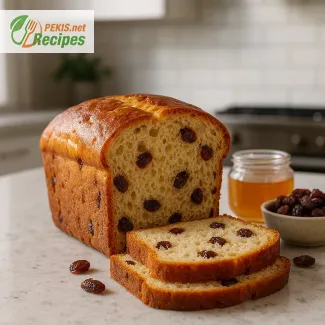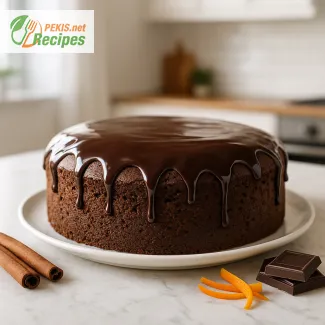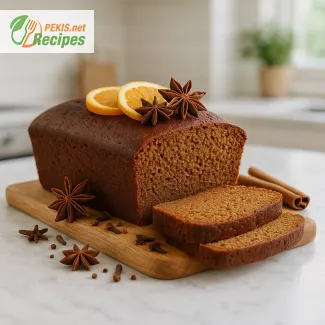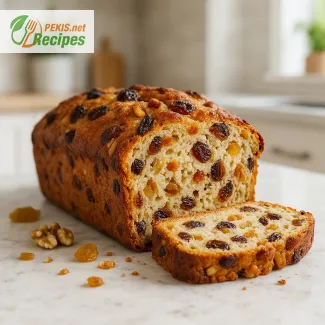Soft and buttery Mini Panettone in a muffin tin makes 8 golden, festive portions ready in just 30 minutes prep, 25 minutes bake, and a total of 145 minutes including rising. Enriched with butter, egg yolks, vanilla, and citrus zest, these mini Italian breads deliver the signature fluffy crumb and sweet aroma of traditional panettone in individual form. Perfect for holiday breakfasts or gifting, they stay fresh for up to 3 days in an airtight container and can be frozen for longer storage. Serve lightly warmed and dusted with powdered sugar for a delicate, aromatic finish.
Years of working with European doughs and festive breads have shown how even complex classics like panettone can be transformed into something simple, light, and beautifully portioned. The texture, the aroma, the slow rise — every step counts, and the smallest details make all the difference between a heavy loaf and a soft, cloud-like crumb. The goal is always balance: warmth from butter, brightness from candied citrus, and a smooth, gentle sweetness that lingers.
PEKIS – a professional chef and recipe developer with over 25 years of experience in cooking and baking, specialized in European and international cuisine, creating recipes that bring professional precision into everyday kitchens.

Irresistibly soft and festive mini panettone baked in muffin tins
A golden Italian tradition made delightfully small and perfect for sharing
Warm, buttery aroma filling the kitchen, pieces of candied orange peel glistening through the soft, yellow crumb — this is the unmistakable charm of the mini panettone. Instead of the tall, towering loaf that needs hours to rise, these individual versions bake quickly in a muffin tin, capturing all the richness and festive flavor of the traditional Italian Christmas bread in a lighter, hand-sized form. Each bite reveals the silky texture of enriched dough balanced with hints of vanilla, citrus, and dried fruit that melt on the tongue.
Unlike the large panettone that originated in Milan, these petite creations were born from the desire to share the same indulgence in smaller portions — ideal for holiday brunches, gift boxes, or a warm breakfast beside coffee or tea. Their airy crumb comes from a delicate balance of butter, egg yolks, and yeast, which together create the signature fluffy and elastic texture. When baked in muffin tins, the dough rises beautifully into golden domes, offering a perfect crust-to-crumb ratio that enhances both aroma and mouthfeel.
The story and essence behind mini panettone
The origins of panettone trace back to the Renaissance courts of Lombardy, where rich, leavened breads were reserved for noble feasts. Over time, bakers refined the recipe, transforming it into a symbol of Italian celebration. The mini version, however, is a modern adaptation — one that aligns with today’s preference for convenience, portion control, and creative presentation. While the traditional loaf can take more than twelve hours to proof, the muffin-sized version brings the same sensory experience in less time, without losing authenticity.
In Italy, these small panettoni are often shared during Natale gatherings, sometimes wrapped individually in paper cups and decorated with powdered sugar or almond glaze. Their elegant shape and balanced sweetness make them equally at home on a breakfast table, dessert platter, or as a thoughtful homemade gift.
Why you’ll love this recipe
- Quick festive treat: Delivers the same rich flavor as traditional panettone but in a fraction of the time.
- Perfect portion size: Individual servings ideal for gifting, parties, or breakfast.
- Soft and buttery texture: The enriched dough bakes into a delicate, moist crumb.
- Customizable flavors: Add chocolate chips, citrus zest, or nuts for your own signature twist.
- Beautiful presentation: Baked in muffin tins for an elegant mini loaf shape.
The role of ingredients in creating the perfect texture
Each element in a mini panettone contributes to its unique identity. Strong flour provides elasticity and structure, allowing the dough to trap air and rise into its signature dome. Butter adds richness and tenderness, while egg yolks give color and a subtle custard flavor. The blend of yeast and sugar ensures lightness, giving the crumb its delicate strands. Dried fruits — such as raisins, candied lemon, and orange peel — infuse bursts of sweetness and fragrance throughout the dough, while vanilla and rum essence enhance the aroma. A touch of milk keeps the texture moist and balanced.
The gentle kneading process develops the gluten network essential for achieving that fluffy, elastic structure, while patient proofing allows complex flavors to mature. The final bake at a moderate temperature creates a golden crust that crackles slightly as you tear it open, revealing the soft, buttery heart within.
How to store and prepare in advance
Mini panettoni are at their best when freshly baked, but they can be stored at room temperature for 2–3 days in an airtight container. For longer keeping, wrap them individually and freeze for up to a month. Reheat briefly in a low oven to restore their softness and fragrance. The dough itself can also be prepared a day ahead and refrigerated overnight — the slow fermentation deepens flavor and simplifies the baking process the next day.
Creative variations and serving ideas
- Chocolate lovers’ version: Replace dried fruit with dark or milk chocolate chips for a decadent twist.
- Citrus delight: Add extra orange zest and drizzle with light lemon glaze once cooled.
- Nutty elegance: Fold in chopped almonds or pistachios for crunch and a hint of earthiness.
- Spiced holiday aroma: A pinch of cinnamon or nutmeg transforms them into cozy winter treats.
- Breakfast indulgence: Slice in half, toast lightly, and spread with butter or marmalade.
Semantically enriched insight – Italian festive baking traditions
Mini panettone stands at the crossroads of Italian heritage, holiday pastry craftsmanship, and modern home baking. It bridges the gap between the long-fermented, artisan loaves of Milanese bakers and today’s desire for approachable, elegant desserts. Whether enjoyed warm from the oven or wrapped in golden paper as a thoughtful gift, these small wonders carry the essence of celebration — the joy of sharing sweet bread made with care and tradition.
- In a large bowl, mix lukewarm milk, dry yeast, and a teaspoon of sugar. Let it stand for 10 minutes until foamy.
- Add egg yolks, remaining sugar, vanilla extract, and lemon zest. Whisk until combined.
- Gradually add strong bread flour and salt, then begin kneading the dough while incorporating softened butter a little at a time. Continue kneading for about 10 minutes until the dough becomes smooth, elastic, and slightly glossy.
- Transfer the dough to a lightly floured surface, shape it into a ball, and place it in a greased bowl. Cover and let rise in a warm place for 60–70 minutes, or until doubled in volume.
- Punch down the dough gently, then fold in raisins and candied orange peel until evenly distributed.
- Divide the dough into 8 equal portions (about 90–100 g each). Shape each into a smooth ball and place them into greased or lined muffin tins.
- Cover lightly and allow to rise again for 20–30 minutes, until puffy and slightly domed.
- Bake in a preheated oven at 180°C (356°F) for 20–25 minutes, until golden brown and fragrant.
- Remove from oven and cool on a wire rack. Dust with powdered sugar (for decoration) once completely cooled.
FAQ questionCan I make mini panettone without special paper molds?
Yes. The recipe is designed to be baked in a standard muffin tin, which replaces traditional tall panettone molds. Grease the cavities well or line them with high muffin liners so the dough can rise upward. Because the batter is an enriched yeast dough, it needs support while rising — the muffin tin walls provide that, giving you a domed, panettone-style shape.
FAQ questionWhy does the dough need two rises?
Mini panettone relies on a well-developed gluten structure and proper yeast activity to create that soft, airy crumb. The first rise allows the dough to ferment, develop flavor, and become elastic. The second rise (after shaping and adding fruits) gives volume inside the muffin tin so the panettone bakes up tall, light, and evenly aerated. Skipping or shortening these rises will make the texture denser.
FAQ questionCan I swap the dried fruit for chocolate chips?
Absolutely. You can replace raisins and candied orange peel with dark, milk, or even white chocolate chips. Add them after the first rise, during shaping, just like dried fruit. Keep in mind that chocolate can melt slightly during baking, so fold it in gently and don’t overbake. This variation is ideal if you want a kid-friendly mini panettone or a sweeter brunch version.
FAQ questionHow do I keep mini panettone soft for longer?
Because they’re small, they dry out faster than a full-size loaf. Once cooled, store them in an airtight container or wrap each one individually in food-safe wrap. For best texture, enjoy within 2–3 days. You can also freeze them, then rewarm briefly in a low oven — this restores the buttery aroma and tender crumb.
FAQ questionWhat’s the best way to prevent the fruit from sinking?
Use well-dried, not wet, fruit and fold it into the dough only after the first rise. You can lightly toss the fruit in a spoonful of flour before adding — this helps it stay suspended. Also make sure the dough is not too soft; a properly kneaded, elastic dough will hold inclusions better, giving you even distribution of fruit in every bite.
FAQ questionCan I make the dough the day before?
Yes. After kneading, place the dough in a lightly oiled bowl, cover, and let it rise slowly in the refrigerator overnight. This cold fermentation deepens the flavor and makes the dough easier to handle the next day. Bring it back to room temperature, fold in the fruit, shape, let it rise again in the muffin tin, and bake. You get the same fluffy, aromatic mini panettone with better time management.
FAQ questionWhy is strong bread flour recommended instead of regular flour?
Strong bread flour contains more protein (gluten), which is essential for supporting the heavy, enriched dough loaded with butter, eggs, and fruit. It helps the dough rise higher and keeps the interior light, stretchy, and pull-apart instead of cakey. Using regular flour can work, but the result may be a bit denser and less tall.
Golden-topped and rich in aroma, Mini Panettone in a muffin tin captures the warmth of traditional Italian baking in an approachable, modern way. The blend of butter, citrus zest, and vanilla creates a harmony of flavors that feels both festive and comforting. Each soft bite reveals the delicate sweetness of candied fruit and raisins, balanced by the tender crumb of perfectly proofed dough.
What makes these mini loaves special is their balance between texture and flavor — a light, elastic interior enclosed in a thin, golden crust. Baking them in muffin tins gives a consistent rise and elegant shape while keeping the process simple enough for any home baker. The result is a treat that looks as impressive as it tastes, perfect for holiday breakfasts, homemade gifts, or weekend indulgence.
Beyond their irresistible taste, these little panettoni embody the spirit of sharing and celebration. Their size makes them easy to wrap, pack, or serve individually, turning every piece into a moment of joy. They also adapt beautifully — add chocolate chips, nuts, or spices to create your own signature version.
Soft, fragrant, and endlessly versatile, Mini Panettone in a muffin tin proves that even a time-honored classic can find a place in today’s kitchens. It’s a reminder that the best festive moments are built on simple ingredients, patience, and a love for baking — one golden, buttery muffin at a time.
Allergens present in the recipe:
- Wheat (gluten) – present in bread flour.
- Eggs – in dough mixture.
- Milk (dairy) – in milk and butter.
Tips for replacing allergens and gluten:
- Replace wheat flour with gluten-free bread mix and add 1 tsp of xanthan gum for elasticity.
- Substitute milk with unsweetened almond or oat milk.
- Use dairy-free margarine or coconut oil instead of butter.
- Replace egg yolks with a mixture of chia seeds and water (1 tbsp chia + 3 tbsp water per egg).
- Vitamin A (µg): 120 – supports vision and immune system.
- Vitamin B2 (mg): 0.15 – aids in energy metabolism.
- Vitamin B12 (µg): 0.4 – supports nerve function.
- Calcium (mg): 45 – strengthens bones and teeth.
- Iron (mg): 1.6 – contributes to red blood cell formation.
- Magnesium (mg): 22 – supports muscle and nerve activity.
- Potassium (mg): 110 – helps regulate fluid balance.
- Vitamin E (mg): 0.8 – protects cells from oxidative stress.
- Polyphenols (mg): 12 – support cardiovascular health.
- Flavonoids (mg): 15 – contribute to anti-inflammatory protection.
- Carotenoids (mg): 0.3 – enhance immune defense.





